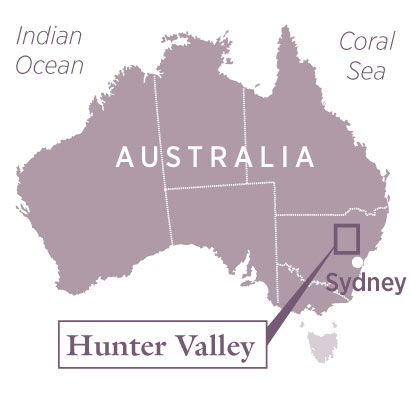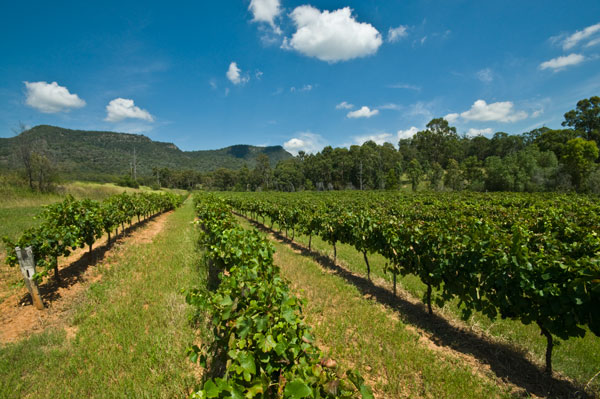A visit to one of Australia’s most historic wine regions will reward both wine lovers and fun lovers alike, says Tyson Stelzer. Read his Hunter Valley travel guide here.
Hunter Valley fact file:

Total planted area: 3,537 hectares
Main grapes: Chardonnay, Semillon, Shiraz, Verdelho
Number of wineries: 160
Quick links:
– Six of the best wineries to visit
– Where to stay, shop, eat and relax
Introduction:
No wine region in Australia offers more for visitors than the Hunter Valley. Less than two hours’ drive from Sydney, the most famous tourist destination in the state of New South Wales is a favourite playground for Sydney siders – and no wonder. It’s packed with resorts, day spas, breweries, a cheese factory, restaurants galore, four golf courses, public gardens, horse riding, multiple art galleries, hot air ballooning, even joy rides in jetfighter planes – not to mention 160 wineries.
Immerse yourself in the raw Australian beauty of hectare upon hectare of picturesque Hunter vineyards for a few days and you’ll quickly discover that even the extravagant tourist trimmings cannot disguise the rugged authenticity of this place. In fact, it’s remarkable that the region is able to produce such outstanding wine at all. The weather is often awful, with erratic, heavy bursts of rain around vintage time. This is one of Australia’s warmest and most humid wine growing regions, and it has large areas of poor soil. But, as everywhere, the finest wines emerge from marginal places, and when nature is kind, the Hunter blossoms. In the turmoil of Australian vintages over the past three years, the Hunter has emerged largely unscathed, making for a superb array of new vintage wines to line cellar door shelves, ripe for discovery by the eager wine traveller. There’s never been a better time to visit.
Something for everyone
The key style to uncover is dry Semillon and no region, anywhere in the world, has championed it like the Hunter. Harvested very early, this crisp, dry, unoaked style is grassy, lemony and fresh in its youth, with an acid backbone as dramatic and constant as the blue silhouette of the Broken back Range, which looms as the backdrop to every Hunter Valley scene. Mature Semillons spanning a decade and longer are a highlight of cellar door tastings, showcasing an extraordinary and amazing transformation to honeyed, nutty, buttery richness.
In a region as warm as this, the elegance, savoury character and fine structure of Hunter Shiraz is a refreshing surprise, and the perfect foil to typically rich Aussie reds. Mature vintages opened for cellar door tastings characterise development from edgy, angular adolescence to the velvety, leathery, gamey complexity of maturity.
The Hunter offers something for everyone, from history buffs to fashionistas. This is one of Australia’s most historic wine regions and a number of wineries established in the 1850s are still going strong today. Among them are Tyrrell’s, Drayton’s and Wyndham’s –Australia’s oldest estate, founded in 1828.Meanwhile, a growing band of dynamic and progressive young winemakers is reviving traditional vineyards and techniques while adding their own modern spin.
The Hunter has set the pace for modern Australian wine culture, thanks to such industry luminaries as Len Evans, ‘the godfather of Australian wine’ and James Halliday, Evans’ protégé, who also established Brokenwood. There is an active culture of mentorship, and an extravagant generosity in sharing knowledge among winemakers. The region has become the nation’s training ground for wines how judges, and a hotbed of exclusive private tastings of old and iconic wines – the inspiration of young and old winemakers alike.
Going for Broke
Thanks to a constant stream of Sydney weekenders and holidaymakers, the Hunter is geared up for wine tourism like nowhere else in Australia. Every brand, small and large, relies heavily on visitors, and the standard of visitor facilities provided is testimony to this importance.
Broke Road is the backbone of the Hunter, with cellar doors lining both sides, and it can become a traffic jam on weekends and public holidays. On busy days, it’s smart to begin a little out of the way, such as McWilliam’s Mount Pleasant Estate. As the day gets busier, make your way between wineries on Broke Road on foot.
You’ll appreciate the exercise, because the Hunter Valley serves up a gastronomic feast to match its wines. Contemporary Australian cuisine is the theme across its finest restaurants, always with a focus on local seasonal produce. Muse Restaurant at Hungerford Hill is one of the most sophisticated gastronomic destinations in the region, and the dynamic chef Troy Rhoades-Brown and his wife Megan may just be the youngest pair ever to be awarded the accolade of best regional restaurant in the state. The Cellar Restaurant at Hunter Valley Gardens serves generous cuisine from local produce around an open fire in winter or alfresco under wisteria vines in summer.
The Hunter Valley offers so much for the visitor that many tourists don’t even get around to wine tasting. Don’t make the same mistake – they have no idea just what they’re missing.

How to get there:
By plane from London to Sydney: either direct (about 22 hours) or stopover in Asia or the UAE. The Hunter Valley is about a two-hour drive from Sydney.
Alternatively, fly to Newcastle; the vineyards are 50 minutes’ drive away
Written by Tyson Stelzer







